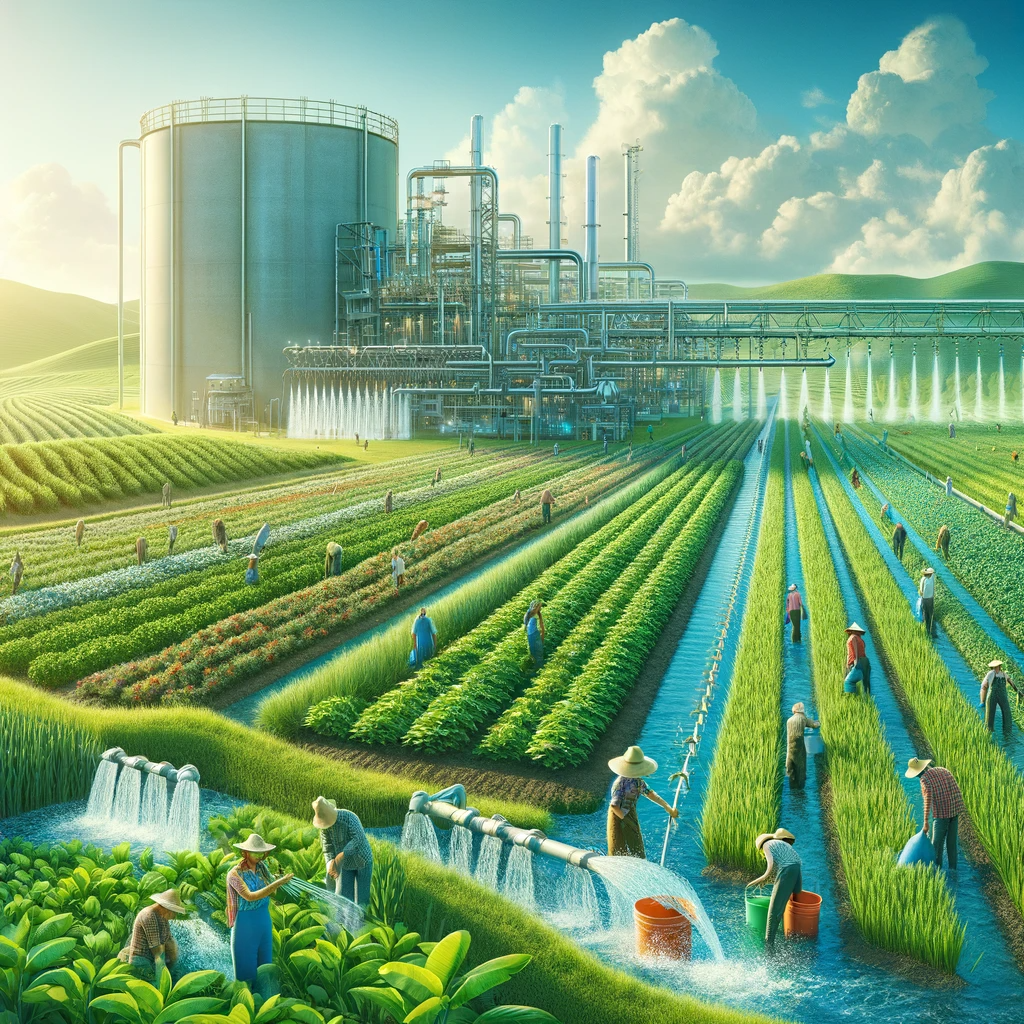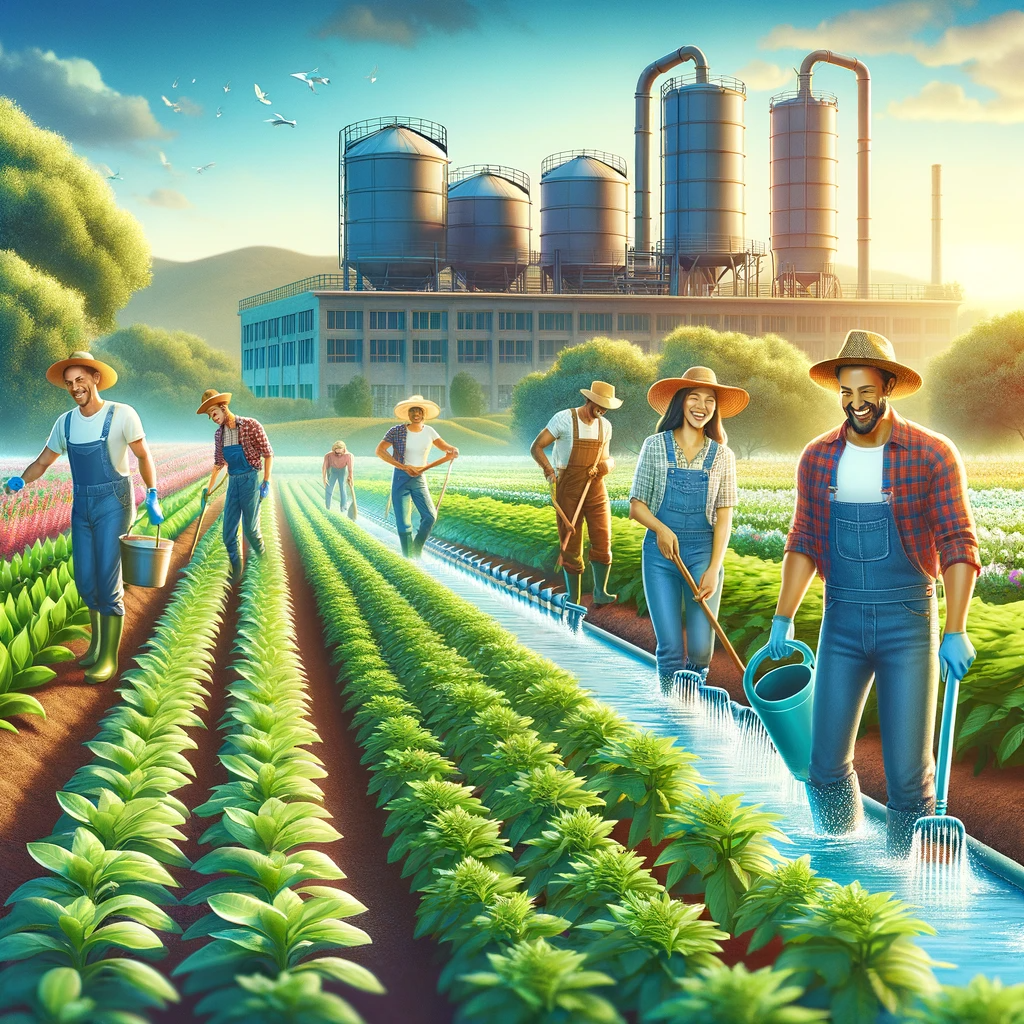Understanding the Concept of Waste Water Supply
The concept of waste water supply has emerged as a game-changer in the field of agriculture. Gone are the days when rivers, Mediterranean seas, and turquoise beaches were polluted with sludge, causing harm to fishermen and beachgoers. Thanks to wastewater treatment plants and the efforts of health authorities in countries like Tunisia, a new era has begun. With the approval of wastewater for agricultural use, communities have witnessed remarkable changes in their economy. Not only has this practice boosted employment opportunities, but it has also addressed the growing demand for water in the face of water scarcity. This innovative system of recycling water has not only ensured the sustainable use of this precious resource but has also resulted in environmental benefits, with levels of pollution in the sea and rivers decreasing by 97%. Scientists and engineers have worked tirelessly to develop the necessary infrastructure, including pipes, pipelines, and submarine outfalls, to transport treated wastewater to farmland. Through rigorous testing and advanced treatment methods, wastewater is transformed into a resource that supports modern farming practices, improving crop yield and minimizing the impact of pollution on marine life. This approach has been successfully implemented in countries all over the world, including those with high population densities and limited freshwater resources. Overall, waste water supply has proven to be a vital solution in addressing the water crisis and ensuring a prosperous future for agriculture.

The Definition of Waste Water Supply
In today’s agricultural landscape, Waste Water Supply has emerged as a new source of prosperity. Waste water, which was once considered a waste product, is now being harnessed and supplied for agricultural purposes. This innovative approach involves treating and reusing wastewater from sewage systems, creating partnerships between finance, agriculture, and water management sectors. By prioritizing the efficient use of water resources, waste water supply has become a guardian against the biodiversity crisis, as it helps replenish soils and ecosystems. Investment in wetlands and water leakage reduction are among the recommended actions outlined in the Dasgupta Review, which calls for a revolution in freshwater systems. Policymakers and industry leaders face various challenges in implementing these recommendations, including the need for financing and changes in current practices, but the potential benefits, such as increased water availability and improved soil fertility, make waste water supply a valuable opportunity for supporting agricultural prosperity.
Waste water supply is a game-changing solution for addressing the pressing needs of the agriculture sector. With around 30% of water consumption attributed to agriculture, the impact of waste water supply in reducing the strain on freshwater resources is significant. This new era in water supply not only ensures a reliable source of water for crops but also helps retain water in the environment. Through processes such as transpiration, where water is released into the air through leaves of plants and forests, waste water supply supports the water cycle and promotes sustainable irrigation practices. By utilizing waste water, farmers and communities can reduce their water footprint and contribute to water conservation efforts. Additionally, waste water supply plays a crucial role in supporting rural communities, especially women who are often on the frontline of water management. By providing a reliable and prosperous water system, waste water supply offers a lifeline to resource-poor areas, making it a vital tool for achieving the United Nations’ Sustainable Development Goals and ensuring a prosperous future for agriculture.
The Origin and Evolution of Waste Water Supply
Waste water supply has come a long way, marking a new era of agricultural prosperity. In the past, waste water was seen as a burden. However, with advancements in technology and understanding, it is now recognized as a valuable resource. Previously, waste water was often disposed of in unsanitary ways, such as being dumped directly into rivers or used to irrigate crops without proper treatment. This led to pollution and adverse impacts on water availability and quality. Governments and water sector operators have now realized the potential of waste water supply and have implemented measures to treat and reuse it effectively. This shift has not only addressed the issue of water scarcity but has also opened up new pathways for agricultural development and economic growth.
The evolution of waste water supply can be traced back to the recognition of the importance of water availability in rural communities. In the early days, households relied on water containers and limited sources for their water needs. However, with population growth and increased demand, the traditional water supply systems faced many challenges. As a result, investments were made to expand access to fresh water supply. This led to the development of wastewater systems, which provided a new source of water for agriculture. With the establishment of wastewater treatment plants, rural areas became more prosperous as they had a reliable supply of water for their crops. This shift not only improved the livelihoods of rural communities but also contributed to the overall well-being of the region.
The Importance of Waste Water Supply in Today’s Agriculture
The importance of waste water supply in today’s agriculture cannot be overstated. Waste water supply has ushered in a new era of agricultural prosperity, providing a new source of water for rural areas that were previously devoid of fresh water supply. This system has not only mitigated the risk of water scarcity for practitioners and policymakers, but it has also ensured the efficient utilization of resources in the face of changing population dynamics. By addressing human insecurity and ecological concerns, waste water supply has forged important connections and links between diverse stakeholders. It has fostered dialogue and knowledge exchange among community members, promoting sustainability and generating innovative ideas to tackle the challenges of our time. With the interest and involvement of various actors, including water companies, the state, and social media platforms, waste water supply has become a pivot point for water management systems and governance. It is a platform for projects and a catalyst for change in water-stressed regions. By providing access to a new water source and involving local communities in its implementation, waste water supply has not only helped combat water scarcity but has also played a crucial role in addressing flooding, evacuation, and environmental concerns. The example of waste water supply in countries like Cambodia and Orissa, India, highlights its significance in ensuring the health and prosperity of agriculture in a rapidly changing context. The rise of waste water supply technologies and regulations for effluent treatment signify a shift towards a more sustainable approach to water pollution and management. Compliance with these regulations and the adoption of effective wastewater treatment processes and methods are imperative for the protection of ecosystems and human health. Moreover, resource recovery from wastewater treatment practices is gaining traction, offering a way to address the complexities of water scarcity and contribute to sustainable development. By preserving water resources and mitigating the threat of waterborne diseases, wastewater treatment not only improves the quality of life but also helps combat soil degradation and other environmental problems. The potential for waste water supply to bring about a prosperous and sustainable future for agriculture is vast. Its viability and resilience make it a necessity in states facing water scarcity and the risk of waterborne diseases. Waste water supply is not just a buzzword; it is a tangible solution that holds the promise of new opportunities and the preservation of our precious water resources. With proper implementation and consideration of the consequences and strategies for treatment, waste water supply can create a positive impact on human health, agricultural productivity, and environmental sustainability.
The Role of Waste Water Supply in Modern Farming
Waste Water Supply: A New Era of Agricultural Prosperity
In today’s modern farming practices, waste water supply plays a crucial role in ensuring a prosperous and sustainable future for agriculture. This innovative system not only addresses the increasing water needs of farming but also offers a range of benefits for energy, economy, and reputation. By utilizing waste water supply, farmers can reduce their reliance on freshwater resources and minimize energy consumption associated with traditional irrigation methods. Additionally, the implementation of waste water treatment facilities provides a glimpse into the potential of resource efficiency, future-proofing agricultural activities to face the surge of climate change and increasing water scarcity. Furthermore, waste water supply contributes to the protection of biodiversity, the well-being of rural communities, and the generation of nutrients for crop production, all while mitigating costs for both the industry and the citizen. The role of waste water supply in modern farming processes is of utmost importance, highlighting its significance in achieving the UN Sustainable Development Goals and creating a sustainable future for agriculture.
Waste Water Supply: A New Era of Agricultural Prosperity
The adoption of waste water supply in agriculture opens up a wide range of opportunities for stakeholders across various sectors. Through the use of advanced wastewater treatment technologies such as anaerobic digestion and membrane bioreactors, the industry can efficiently repurpose waste water, thereby reducing greenhouse gas emissions and improving resource conservation. Moreover, waste water supply can be integrated into other areas, such as cooling systems in textiles or wetlands for natural filtration. To fully realize the benefits of waste water supply, active collaboration between government, businesses, consulting firms, and technology providers is crucial. Policy support and funding should be directed towards the development of infrastructure and the adherence to sustainable practices. By doing so, waste water supply can become a catalyst for progress in food processing, contributing to the prosperity of regions like Jharkhand, Bihar, Odisha, and West Bengal. With the implementation of innovative approaches to runoff management and the efficient use of water resources, waste water supply demonstrates its potential as a sustainable solution that addresses the growing demand for water in agriculture while safeguarding the environment and ensuring the well-being of both farmers and consumers.
The Benefits of Waste Water Supply for Agricultural Prosperity
Waste Water Supply: A New Era of Agricultural Prosperity
Waste water supply has emerged as a new source of agricultural prosperity in many countries, providing valuable benefits to both rural and urban communities. One of the key advantages of waste water supply is the provision of sanitation systems, ensuring that communities have access to clean and safe water for various purposes. Additionally, waste water supply plays a crucial role in replenishing soil moisture and nourishing crops, leading to increased agricultural productivity. This not only helps to meet the growing demand for food in the country but also reduces the pressure on other forms of water supply. By utilizing waste water, farmers can minimize the cost of irrigation and increase their resilience to water scarcity. Researchers estimate that waste water can be effectively used for irrigating vegetables, watering lawns and gardens, benefiting millions of people. The circularity of waste water in agriculture contributes to protecting water resources and reducing poverty, while minimizing the release of harmful bacteria and contaminants to the environment. Overall, waste water supply is a vital link between agriculture, water, and sanitation, highlighting the importance of the nexus thinking in fostering sustainable development.
The Benefits of Waste Water Supply for Agricultural Prosperity
The benefits of waste water supply for agricultural prosperity are not limited to the end-users alone. Waste water supply also promotes the wellbeing of cities and the sustainable development of ecosystems. By providing a new source of water for agriculture, waste water supply relieves the pressure on fresh water resources, which are often scarce in urban settings. This helps to ensure the availability of water for other purposes, such as drinking and industrial use, in densely populated areas. Moreover, waste water can be treated and reused, thus reducing the need for extensive extraction of water from rivers, lakes, aquifers, and wetlands. This contributes to the preservation of natural ecosystems and the protection of water quality. Waste water supply also facilitates the implementation of sustainable water and sanitation standards, as demonstrated by numerous case studies around the world. By harnessing the potential of waste water supply, countries can achieve the goals of sustainable agriculture, water management, and rural development. However, the successful implementation of waste water supply requires the cooperation and engagement of all stakeholders, including policy actors, researchers, practitioners, and the general public. Capacity development initiatives, workshops, and partnerships play a crucial role in sharing knowledge, expertise, and good practice examples, supporting the transition towards a prosperous and sustainable future.
The Mechanics of Waste Water Supply in Farming
The mechanics of waste water supply in farming have become essential in shaping a new era of agricultural prosperity. In order to effectively address this issue, knowledge exchange, leadership, and capacity development workshops have been organized in various countries. These workshops aim to impart knowledge on waste water treatment technologies and water resource scarcity management. Policymakers, scientists, and representatives from member states gather to discuss policies and share best practice examples. The workshops shed light on the importance of understanding the mechanisms behind waste water supply in order to ensure sustainable practices. The discussions also focus on the alternative and combination of technologies for water efficiency and recycling. Through these capacity-building activities, stakeholders are empowered to adapt to the challenges of waste water supply in farming, ultimately driving agricultural prosperity and sustainability.
The Process of Waste Water Treatment for Agriculture
In today’s era of agricultural prosperity, waste water supply plays a crucial role in ensuring a sustainable and prosperous future for rural communities. The process of waste water treatment for agriculture is a vital component of this new era. It involves the careful treatment and purification of waste water, transforming it into a valuable resource that can be used to supply fresh water to agricultural systems. This innovative system provides a new source of water that can be supplied on a large scale, supporting the growth of agricultural production and addressing the challenge of water scarcity in many regions. With proper planning and regulation, waste water treatment for agriculture can contribute to improved water-use efficiency, environmental conservation, and the promotion of sustainable development. As countries around the world, from Iran to South Africa, begin to implement these strategies, valuable insights and lessons can be gained to further refine and enhance waste water treatment systems in the future.
The Infrastructure Required for Waste Water Supply
Waste water supply has become a crucial component in ensuring a new era of agricultural prosperity. With the ever-increasing demand for food and the depletion of fresh water resources, there is a need for alternative sources of water supply. Waste water, once considered a pollution hazard, is now being recognized as a valuable resource that can be effectively utilized in agriculture. The infrastructure required for waste water supply includes a well-planned network of treatment plants, pipes, and storage systems to ensure the safe and efficient supply of water to rural areas. This new source of water, supplied through waste water systems, has the potential to support agricultural activities, enhance water resource management, and promote sustainable development in the agricultural sector.
The adoption of waste water supply in agriculture brings forth several reasons for advocacy. Firstly, it addresses the issue of water scarcity by providing an additional source of water for irrigation and other agricultural purposes. This is especially crucial in regions where water resources are limited, such as North Africa. Additionally, waste water supply can contribute to food security by augmenting crop yields and supporting sustainable agricultural practices. Moreover, the infrastructure required for waste water supply can also help in reducing the pollution of waterbodies, mitigating the risks of flooding, and improving soil and plant health. From an ecosystem perspective, the value of waste water supply extends beyond agriculture, encompassing ecosystem services and hydroelectricity generation. Considering the increasing demand for food, the need for a prosperous and sustainable rural economy, and the conservation of fresh water resources, waste water supply holds immense potential for supporting agriculture and ensuring a prosperous future.
The Future of Waste Water Supply in Agriculture
The future of waste water supply in agriculture holds the potential for a new era of agricultural prosperity. As the world faces increasing challenges in water availability and quality, policy makers and farmers are exploring new means of stimulation to ensure sustainable water supplies. Techniques and processes must be reevaluated and regimes changed in order to address the implications of overextraction and degradation. In this chapter, we will examine the changing situation in waste water supply and its implications for food self-sufficiency. We will also provide an overview of case studies and achievements in waste water distribution and usage, as well as the suite of methods and frameworks being developed to address water resource exploitation and contamination. By reassessing the evidence and promoting innovation, waste water supply can play a crucial role in achieving long-term sustainability and poverty alleviation in agriculture.
Technological Advancements Impacting Waste Water Supply
Technological advancements have revolutionized waste water supply in agriculture, ushering in a new era of agricultural prosperity. With the development of sophisticated systems, waste water can now be efficiently treated and supplied over long distances to agricultural grounds. This has significantly expanded the availability of fresh water for farming, ensuring a steady supply of water for crops, animals, and foodstuffs. Additionally, these modern waste water supply systems have reduced the reliance on groundwater resources, minimizing the impact on groundwater levels and contributing to sustainable water management practices.
In the past, waste water supply was often limited by constraints such as the location of agricultural grounds and the availability of return flows. However, technological advancements have enabled the construction of extensive networks of pipes and canals, facilitating the transportation of waste water to even the most remote areas. This has opened up new opportunities for agricultural development, particularly in regions like Sub-Saharan Africa, where water scarcity has historically posed challenges to food production. By utilizing waste water supply systems, farmers can now effectively irrigate larger crop areas and produce higher food supplies, contributing to improved food security and rural prosperity.
Potential Challenges and Solutions for Waste Water Supply in Farming
The potential challenges of waste water supply in farming are manifold. One of the main difficulties is the lack of proper infrastructure to treat and distribute waste water efficiently. This can lead to issues such as soil salinization and crop water stress, affecting the overall productivity of agricultural systems. Additionally, the high cost of implementing and maintaining waste water treatment facilities pose a significant financial burden on farmers. Moreover, the effectiveness of waste water supply can be hampered by inequalities in resource access, particularly in impoverished regions where planning and action plans are often lacking. Furthermore, the fluctuation in water availability due to climate change and other weather events add to the challenges faced in the deployment of waste water supply systems.
However, despite these challenges, there are potential solutions that can address these issues and ensure a prosperous era of agricultural development through waste water supply. One approach is the adoption of advanced technology and sustainable farming practices to mitigate the negative impacts of waste water on the environment and human health. This includes implementing efficient irrigation systems that minimize water losses and adopting crop varieties that are resistant to salinity and water stress. Additionally, governments and international donors can play a crucial role in supporting farmers by providing financial incentives and technical assistance to promote the deployment of waste water supply systems. Moreover, water pricing mechanisms can be implemented to encourage efficient use of waste water and ensure fair and equitable access among farming communities. By taking these measures, waste water supply can become a new source of fresh water supply for agriculture, leading to increased agricultural production and improved rural livelihoods.
Real World Examples of Waste Water Supply Application
Real World Examples of Waste Water Supply Application
Waste Water Supply: A New Era of Agricultural Prosperity has revolutionized the way we approach agriculture. In many parts of the world, waste water is being utilized as a new source of fresh water supply for rural areas, leading to a more prosperous and sustainable farming system. For instance, in the Netherlands, waste water is treated and supplied to houses and farms, improving the landscape and reducing costs. In the United States, the wetland mitigation policy has encouraged the use of waste water for flood protection and resource use. In terms of agriculture, waste water is rich in nutrients like fertilizer, which eliminates the need to purchase expensive equipment and reduces costs for individuals, such as meat and crop farmers. Additionally, waste water supply has significant health benefits by reducing the risk of water-related diseases. Overall, waste water supply is not only a crucial tool for agricultural prosperity but also for the well-being of individuals, society, and future generations.
Case Study 1: Success of Waste Water Supply in Agriculture
Case Study 1: Success of Waste Water Supply in Agriculture
The implementation of waste water supply schemes has brought forth a new era of agricultural prosperity in various parts of the world. One such success story can be found in the southern region of the United States of America. In this area, farmers have been able to overcome the limitation of water scarcity through the reuse of wastewater for agricultural purposes. By using wastewater from various sources, including drinking water treatment plants and wastewater management systems, farmers have been able to ensure a consistent and reliable supply of water for their crops. This has reduced their vulnerability to food insecurity and hunger, while also promoting the sustainable development goals of the government. Through proper wastewater management and the prioritization of water resources, this region has successfully harnessed the potential of waste water supply to support agricultural development and improve the livelihoods of its rural populations.
Case Study 2: Overcoming Challenges with Waste Water Supply
Case Study 2: Overcoming Challenges with Waste Water Supply
The use of waste water supply has opened a new era of agricultural prosperity by providing a new source of water for rural areas. However, there are challenges that need to be addressed in order to ensure its successful implementation. According to a research paper, lack of appreciation and understanding of the importance of waste water supply is one of the main problems. A number of public organizations and city administrations have implemented waste water supply projects, but the proportion of the population that actually needs and uses this system remains low. This indicates a need for better data collection and evaluation of the potential benefits of waste water supply, as well as investments in infrastructure and education to increase awareness and promote its use.
In the case of Toowoomba, Australia, the city faced challenges in implementing waste water supply due to public perception and lack of trust in the system. The city proposed a plan to use treated waste water for drinking purposes, but it faced strong opposition. However, after a thorough discussion and evaluation of the benefits and risks, the project was approved and successfully implemented. This example suggests that overcoming challenges with waste water supply requires effective communication and engagement with the public, as well as a comprehensive assessment of the potential risks and benefits.
Ensuring Safe and Effective Waste Water Supply
Ensuring the safe and effective supply of waste water is crucial for agriculture to thrive in this new era of prosperity. There are inherent risks involved in using waste water, especially if it is sourced from surface water reservoirs. Therefore, proper treatment processes at water treatment plants must be in place to eliminate contaminants and ensure the water is safe for agricultural use. Collaboration between individuals, governments, and organizations is vital to establish measures and regulations that protect water bodies and ensure the quality of waste water supply. In East Asia and Southeast Asia, for example, regulations and sanitation goals have been implemented to monitor and improve water quality. Cities and policy makers have set targets and put monitoring systems in place to prevent the possibility of disease outbreaks. Furthermore, education and awareness building play a crucial role in changing the views and considerations of individuals towards waste water supply. River stretches with high levels of biochemical oxygen demand and other pollutants pose a risk to millions of people who rely on those water sources. Risk assessment frameworks and groundwater monitoring by environment agencies are necessary to understand the pressures and risks associated with waste water supply. In some cases, implementing demand-side practices such as water conservation actions can help alleviate the burden on waste water supply systems. Improvements and expansions in waste water treatment processes are also necessary to ensure the safety and quality of the water used for agricultural purposes. Politicians and decision-makers must prioritize the conservation of water resources, especially during periods of drought, to prevent any parallel disruptions in waste water treatment capacity. By keeping these considerations in mind, waste water supply can become a sustainable and reliable source for agricultural production, contributing to a prosperous and water-efficient future.
Health and Environmental Impacts of Waste Water Supply
Waste water supply has ushered in a new era of agricultural prosperity, providing a sustainable and reliable source of fresh water for rural communities. However, it is important to consider the health and environmental impacts of this initiative. Household water treatment methods may not effectively remove all contaminants from waste water, posing potential risks to our bodies and surface water bodies when used as an alternative water supply. Moreover, the presence of nitrates and other pollutants in waste water can lead to the degradation of drinking water supplies. Research needs to be conducted to fill knowledge gaps and develop strategies to mitigate these health effects.
In regions like Australia and Europe, waste water supply has become a crucial component of water management tools. However, challenges such as seawater intrusion and the replenishment of aquifers need to be addressed. The strategy in India, for example, involves the installation of waste water projects and filtering systems to ensure the availability of clean water. Utilities, factories, and even city streets contribute to the collection of waste water, highlighting the need for effective waste management strategies. Monitoring and ensuring access to safe drinking water is a responsibility of environmental protection agencies and water resource groups. By addressing these issues and adopting sustainable practices, waste water supply can play a vital role in ensuring water security and resilience for agriculture and beyond.
Regulatory Considerations for Waste Water Supply in Agriculture
Regulatory considerations for waste water supply in agriculture play a crucial role in ensuring the successful implementation of this new era of agricultural prosperity. The natural resource management ministerial council, research councils, and analysis and accounting organizations, such as the water industry research and operations management research, conduct studies and reviews to assess the impact of waste water supply on the environment and public health. Additionally, organizations like the World Health Organization and water policy groups provide guidelines and regulations for efficient and safe waste water supply. These regulatory measures focus on factors like water quality inventory, water recycling, and the use of oxidation processes to ensure the realisation of a diverse and hygienic waste water supply system.
The involvement of decision-makers and engagement with various stakeholders is crucial for the effective implementation of waste water supply regulations in agriculture. The establishment of protocols and regulations by organizations like the Environment Protection Commission and water resources control boards in America and Oceania ensures that waste water supply practices align with environmental standards and guidelines. Reports and initiatives by organizations like the World Health Organization and UNICEF provide valuable insights and lessons for decision-makers, highlighting the importance of safe water supply for children’s health and the role of waste water supply in mitigating water crises. Overall, regulatory considerations focus on the safety, efficiency, and innovation of waste water supply, aiming to fulfill the objectives of sustainable agriculture and self-sufficiency in water resources.
Conclusion
Waste Water Supply: A New Era of Agricultural Prosperity
In this article, we have explored the concept of waste water supply and its importance in today’s agriculture. We have discussed the role of waste water supply in modern farming and the benefits it brings for agricultural prosperity. We have also looked at the mechanics of waste water supply in farming, including the process of waste water treatment and the infrastructure required for its implementation. Furthermore, we have examined the future of waste water supply in agriculture, considering technological advancements and potential challenges that may arise. We have also delved into real-world examples of waste water supply application, highlighting successful case studies and the overcoming of challenges. Ensuring safe and effective waste water supply is crucial, and we have discussed the health and environmental impacts of waste water supply, as well as regulatory considerations. As we conclude, it is clear that waste water supply has the potential to revolutionize agriculture, providing a sustainable and reliable source of water for farming. With proper process control considerations, the utilization of waste water constituents, and the exploration of alternative water sources, waste water supply can contribute to a prosperous and prosperous rural future.
FAQ
What is waste water supply?
Waste water supply refers to the use of treated or untreated wastewater for agricultural purposes, such as irrigation or fertilization.
Why is waste water supply important in agriculture?
Waste water supply provides a sustainable and cost-effective source of water and nutrients for crop production, leading to increased agricultural productivity and prosperity.
How does waste water supply benefit agriculture?
Waste water supply helps to reduce reliance on freshwater sources, conserve water resources, improve soil fertility, and enhance crop yields, ultimately leading to increased profitability for farmers.
What is the process of waste water treatment for agriculture?
Waste water treatment for agriculture typically involves physical, chemical, and biological processes to remove impurities and pathogens from wastewater, ensuring its safe use in farming activities.
What infrastructure is required for waste water supply in agriculture?
Infrastructure for waste water supply includes collection systems, treatment plants, storage facilities, and distribution networks to safely deliver treated or untreated wastewater to agricultural fields.
What are some technological advancements impacting waste water supply in agriculture?
Advancements in wastewater treatment technologies, water monitoring systems, and precision irrigation techniques are revolutionizing the efficiency and effectiveness of waste water supply in agriculture.
What are the potential challenges and solutions for waste water supply in farming?
Challenges include addressing water quality concerns, managing public perception, and ensuring compliance with regulations. Solutions involve implementing robust treatment processes, conducting education and outreach programs, and maintaining a strong regulatory framework.
Can you provide real-world examples of waste water supply application in agriculture?
Yes, examples include the use of treated wastewater in California’s Central Valley for crop irrigation and the successful implementation of waste water supply projects in arid regions like Israel and Australia.
What are the health and environmental impacts of waste water supply?
Properly treated waste water supply poses minimal health risks and can actually enhance soil fertility. However, if not managed correctly, it can lead to the contamination of water sources and the spread of waterborne diseases.
What regulatory considerations exist for waste water supply in agriculture?
Regulations typically govern the treatment and use of wastewater, ensuring its safety for agricultural purposes. These regulations vary by country and region, and compliance is essential to protect public health and the environment.
In conclusion, what does waste water supply mean for the future of agriculture?
Waste water supply offers a promising solution to address water scarcity and promote sustainable agriculture. By harnessing this valuable resource, farmers can achieve greater productivity, resilience, and prosperity in the face of evolving environmental challenges.




